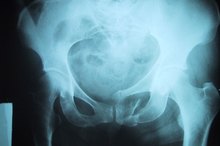Types of Pelvic Calcifications
Pelvic calcification occurs in both children and adults and is caused by a variety of factors 1. The proper treatment of this painful condition depends on the medical professional correctly identifying by X-rays the type of calcification deposit and its root cause. Diet or medication may alleviate chronic inflammation and prevent future calcification 1.
Concretions
Concretions typically form in pelvic veins when calcium salt falls out of solution. When this occurs repeatedly, calcified layers solidify and build on one another, filling what should normally be a hollow structure within the pelvis. Depending on the frequency of deposits, concretions may form smooth or irregular calcification. Lucent calcifications are the result of infrequent salt deposits, while dense concretions form from regular calcium salt falls, which cause layers to accumulate rapidly. The layered appearance is specific to this type of calcification, so diagnosis can be made with certainty.
- Concretions typically form in pelvic veins when calcium salt falls out of solution.
- Lucent calcifications are the result of infrequent salt deposits, while dense concretions form from regular calcium salt falls, which cause layers to accumulate rapidly.
Conduit Wall
Treatments for Pelvic Phleboliths
Learn More
Although the formation of conduit-wall calcification is most common in the abdominal aorta, these deposits can form in any internal channel that conveys fluids, including pelvic blood vessels. Conduit-wall calcification should not be mistaken for cyst wall calcification, which is similar in structure but larger in diameter, due to the fact that conduit-wall calcification commonly occurs in capillaries, the smallest channels in the pelvis. X-ray appearance ranges from a series of specks to branching tracks or ring-like densities.
Phleboliths
Phleboliths are stones that form within pelvic veins and are considered a type of concretion due to their structure. Phleboliths in their initial stages are considered incidental and radiologists frequently do not document their presence in medical reports. They are officially considered concretions when they form in the lower half of the pelvic inlet. Unlike other calcification types, phleboliths are unique to the pelvis.
- Phleboliths are stones that form within pelvic veins and are considered a type of concretion due to their structure.
Endometriosis-Related Calcifications
What is a Pelvic Phlebolith?
Learn More
Pelvic calcifications sometimes accompany endometriosis or mimic endometriosis symptoms. The reason for this is still unknown; however, women suffering from chronic pain in the pelvic area should keep this possibility in mind. If normal endometriosis excision does not relieve the pain, or tests reveal that endometriosis is not present, women should request a check for pelvic calcification in addition to the routine exams for ovarian cysts or fibroid tumors.
Related Articles
References
- "Dynamic Chiropractic"; A Review of Abdominal Calcifications; John M. Bassano; February 2007
- "Essentials of Radiology"; Fred A. Mettler; 2004
Writer Bio
Adelaide Tresor has been a technical writer and book editor since 2006. Her work has been published by Thomson Reuters and Greenhaven Press, including several "At Issue" titles. Tresor holds a bachelor's degree in journalism and is also a certified teacher with experience in English, mathematics, chemistry, and environmental science. She currently teaches AP Physics.








